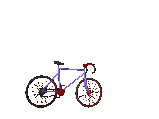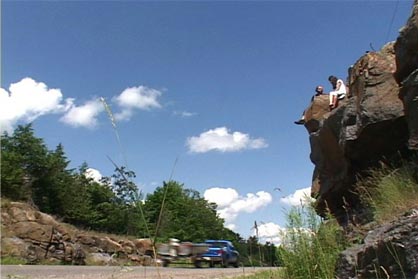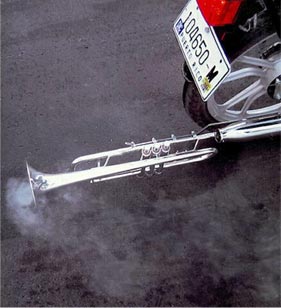
|
Lorna Mills and Sally McKay
Digital Media Tree this blog's archive OVVLvverk Lorna Mills: Artworks / Persona Volare / contact Sally McKay: GIFS / cv and contact |
View current page
...more recent posts

Omigod I love Wikipedia. Somebody uploaded this gorgeous gif of their own MRI scan.
Here's some more nice brains:
 |
 |
 |  |
Listening to Vilayanur S Ramachandran has got me looking for pictures of grey matter. His lecture on art, that I quoted earlier, was okay, but his stuff on "self" and his bizarre case studies (a la Oliver Sacks) are fabulous. He's extreme in his physiological outlook. Here's a quote:
What exactly do people mean when they speak of the self? Its defining characteristics are fourfold. First of all, continuity. You've a sense of time, a sense of past, a sense of future. There seems to be a thread running through your personality, through your mind. Second, closely related is the idea of unity or coherence of self. In spite of the diversity of sensory experiences, memories, beliefs and thoughts, you experience yourself as one person, as a unity.
So there's continuity, there's unity. And then there's the sense of embodiment or ownership - yourself as anchored to your body. And fourth is a sense of agency, what we call free will, your sense of being in charge of your own destiny. I moved my finger.
Now as we've seen in my lectures so far, these different aspects of self can be differentially disturbed in brain disease, which leads me to believe that the self really isn't one thing, but many. Just like love or happiness, we have one word but it's actually lumping together many different phenomena. For example, if I stimulate your right parietal cortex with an electrode (you're conscious and awake) you will momentarily feel that you are floating near the ceiling watching your own body down below. You have an out-of-the-body experience. The embodiment of self is abandoned. One of the axiomatic foundations of your Self is temporarily abandoned. And this is true of each of those aspects of self I was talking about. They can be selectively affected in brain disease.


Best bad joke award goes to Kevin Radigan. The third year OCAD sculpture student proved that just one person can create massive change...(heh). His installation of giant arrow and nickels is a welcome intervention on the AGO's "Massive Change" signage (which I already complained about here). While I was down there today taking pictures, passersby were laughing and stopping to chat. Lots of media interest too, and apparently the AGO are talking about making the installation permanent. I guess everyone is getting pretty sick of that big friggin sign!
 |  |  |  |  | |
 |  |  | |||
Thanks Tino, for the link to bike gifs!

Neurologist Vilayanur S Ramachandran on art (from BBC Reith Lectures 2003 online) (thanks to Marc Ngui):
Let's assume that 90% of the variance you see in art is driven by cultural diversity or - more cynically - by just the auctioneer's hammer, and only 10% by universal laws that are common to all brains. The culturally driven 90% is what most people already study - it's called art history. As a scientist what I am interested in is the 10% that is universal - not in the endless variations imposed by cultures. The advantage that I and other scientists have today is that unlike we can now test our conjectures by directly studying the brain empirically. There's even a new name for this discipline. My colleague Semir Zeki calls it Neuro-aesthetics - just to annoy the philosophers.Ramachandran's 10 universal laws of art:
- Peak shift
- Grouping
- Contrast
- Isolation
- Perception problem solving
- Symmetry
- Abhorrence of coincidence/generic viewpoint
- Repetition, rhythm and orderliness
- Balance
- Metaphor

G.L.N., Space Ship Earth: Highway 44, 2004. From the Power Plant website
I was recently in conversation with a group of artists, all of whom were upset about Sarah Milroy's Globe and Mail review of the current Power Plant show, Dedicated to you, but you weren't listening. Having neither seen the show, nor read the review, I kept my mouth shut except to ask, "Did you disagree with her?" The answer I got was indirect, "She acted irresponsibly when she trashed the younger, local artists." This is a normal, almost commonsense point of view, but it kind of bugs me. Wouldn't it be more irresponsible for a journalist to hold her tongue, and refrain from calling it as she sees it? Art writing is hard, all the community pressure on a writer is towards promotion, while the editorial pressure is towards sensationalism and "news." I respect Milroy for sticking to her own path and if she errs on the side of crabby rather than chummy I'm all for it. All that said, I sometimes disagree with Milroy's point of view. So I went to see the show for myself.
I was impressed with the low-key metaphysics, ambition and transcendence, with a minimum of sensationalism. Two pieces were particular highlights for me, "Space Ship Earth" by G.L.N. (Maura Doyle and Tony Romano) and "Returning a Sound" by Jennifer Allora and Guillermo Calzadilla. "Space Ship Earth" will appeal to anyone who has ever identified with David Bowie's character in The Man Who Fell to Earth. With disorienting Nicholas Roeg-style camera, the two artists set up durational shots in which they play spooky ambient music in outdoor environments, recording the indigenous sound and re-inserting it into the mix. Cars whizzing past are re-cast with technological humming undertones, blue jays cries are repeated, wind and water are amplified. Sun and shadow play subtle visual games, casting grasses and rocks as the visual protagonists, throwing the environment, and by extension the planet, into surreal relief. In one sequence, an agitated black cat prowls in front of the camera, often blocking the view entirely. In another the artists and their gear are hidden in a meadow of tall grasses and wildflowers that fill the screen. In my favourite sequence, they sit perched high on a rock by the highway, the passing cars like space ships or weird animals, the clouds above suspended like space ships or weird animals in a perfect blue sky.

Jennifer Allora & Guillermo Calzadilla, Returning a Sound, 2004.
From the Power Plant website
In Jennifer Allora and Guillermo Calzadilla's "Returning a Sound" a young man rides a scooter with a trumpet attached to his tailpipe. This produces a remarkable compelling tone, that shifts range and volume as he revs the engine. Chin held high, the guy zooms past buildings, beaches, enormous trees dropping flowers and lush green fields, the trumpet ringing out a surprisingly muscial call. He is riding around his home on Vieques — an island off Puerto Rico — which was used by US military as a bombing test site for 60 years. The piece is an eloquent but undidactic testament to the work of local protestors who eventually managed to reclaim their land.
Another notable piece was "Open Access," a doorway cut into the west wall by artists Julio Castro, Gabriel Cazares and Roland Flores. The door swings open, providing free gallery access to anyone who wanders in. Dan Graham's "Opposing Mirrors and Video Monitors on Time Delay," was an optical adventure in disorientation, but we expect nothing less. Dave Allen's charismatic starlings have tons of personality — and they look happy in their gigantic cage — although the idea that they might begin to vocally mimic the musical compositions that are being played for them seems somewhat incidental to the novelty of looking at starlings as if they were precious and interesting creatures (they do have beautiful plumage, as a matter of fact, and a plucky urbane style).
All the works involve some form of collaboration. According to curator Reid Shier, the show poses the question, "What is the nature of authorship when multiple, perhaps contradictory, voices are invited to come together in the production of a work?" Zin Taylor's strange non-collaboration with Japanese musician Aki Tsuyuko is a case in point. Never having met Tsuyuko, Taylor made a video inspired by her music. His video is an exploration of dirt piles in extreme close up, the image breaking down into buzzing video dust in darkest shadows. The camera slowly pans by gaping holes, weird orifices in the dirt. In an accompanying booklet, correspondence between Taylor and Tsuyuko reveals that the musician is mystified, unimpressed and possibly slightly insulted by Taylor's interpretation of her music. The piece is poignant, Taylor stretches for something ineffable in the video, then sends his art across the world, and fails to make a meaningful connection. In this climate of hegemony and global trade, its an unexpected surprise.
In the light of current draconian attitudes to community postering, Derek Sullivan's "Endless Kiosk" should be a beautiful urban gesture. Placed in the public foyer outside the gallery, the piece is a pole that people can use to put up notices, art, refuse, love-letters, or whatever other paper products they'd like to share with other passersby (a fresh bucket of wheat paste is provided). Unfortunately, the area is not a functional public commons. People come to Harbourfront for specific events, usually in cars, and then leave again. They rarely linger, but when they do mingle they are strategically schmoozing and posing, not shamelessly posting promotion. The pole's offer of a public forum is so-far un-exploited, and the piece seems forlorn.
*************************************************
After writing the above paragraphs, I read Sarah Milroy's review and found that indeed, we mostly disagree. G.L.N.'s "Spaceship Earth" was by far my favourite piece, striking a deep and resonant chord, while she suggests these artists are "fiddling around on the margins." I felt that Johnathan Monk's "Searching for the Centre of a Piece of A4 Paper" was an empty, art-joke gesture, while for her it evoked "two dragonflies mating in midair, never quite achieving a resting point of consensus." Milroy's overall take on the show was negative and she ends her piece with a kicker: "These are wry, miniature epiphanies, offered up half-heartedly to the world, not quite witty or inventive enough to evoke Duchamp." Perhaps I'm just more partial to conceptual art, but overall I found the show engaging and profound. Its a good thing, though, that writers have different points of view. I don't think Milroy was gratuitously mean in her critiques, and she gave the whole show careful atttention. In my review, I left out the works that did not mean much to me, rather than digging in to criticize. Does the fact that I am an artist as well as a writer make me too chicken of my colleague's feelings, and therefore unable to be properly critical? I hope not. I'm not normally squeamish about stating my opinions. But I do make a conscious attempt to say something generative if I am going to say anything at all, and I know the boundary between being positively oriented and being scared to say "boo" is one that requires vigilance. For that reason I respect and appreciate Milroy's role as an art critic in this town, and I am glad she does not coddle the local youngsters when she truly doesn't like what they are doing.